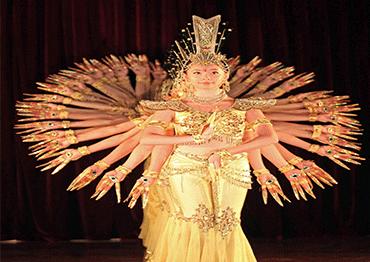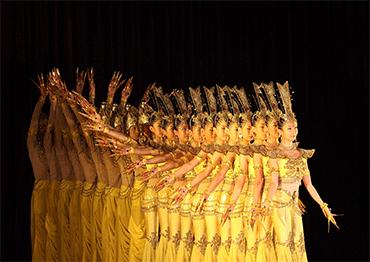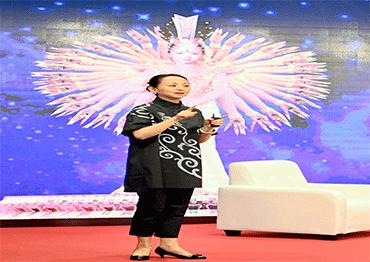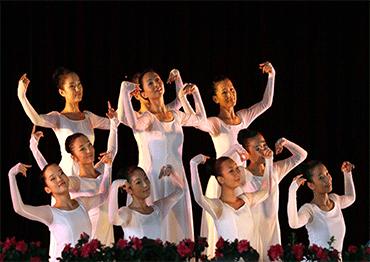t the 2005 Spring Festival Gala, broadcast nationwide by China Central Television, a performance called Dance of the Thousand-Hand Guanyin, performed by the China Disabled People’s Art Troupe, became an instant sensation. All 21 members of the group were deaf.
The exquisite synchronized dance, created by Chinese choreographer Zhang Jigang, was first performed at the closing ceremony of the 2004 Paralympic Games in Athens as the city handed over hosting duties to Beijing for the 2008 edition of the Games. For nearly two decades, the troupe has toured extensively overseas, and performed at prestigious venues including the Kennedy Center in Washington, DC.
The Buddhist Goddess of Mercy and Compassion, known as Guanyin in China, is worshipped by those facing troubles and illness, or seeking love or pregnancy. In her most popular image, she is depicted as having a thousand arms.
In an exclusive interview with China News Service, Tai Lihua, who was the principal dancer at the Gala performance and now leads the troupe, shared her thoughts on how their performances, blended with traditional Chinese culture and modern artistic expression, are able to dance into the heart of audiences all over the world.
CNS: In 2005, you rose to fame as principal dancer in the Spring Festival Gala performance of Dance of the Thousand-Hand Guanyin. What was its significance for China’s disabled people and the development of disability arts?
Tai Lihua: Images of rehearsing the dance are still vivid in my mind even today. It was a backbreaking task, but the 21 of us in the troupe really worked together as if we were one person. We didn’t expect it to become such a hit, but it did become a major milestone in the development of the troupe.
China’s disability arts have experienced two development stages. In the first stage, people got to know and accepted special arts through performance. In the second stage, the spiritual pursuits of the disabled through special arts performances are shown to inspire the true, kind and beautiful nature in people’s hearts. In our performances, we convey positive beliefs and strengths, break the barriers of disability, and showcase our own value, self-esteem and self-confidence. Through appreciating special arts and the talents of the disabled, people have also changed their prejudices that the disabled are just those who need sympathy.
In the past, for example, when we used sign language in public places, people always stared, but it was less common after Dance of the Thousand-Hand Guanyin became a hit. People gave us a thumb’s up instead. This gave us a long-lost sense of dignity and boosted the confidence of disabled people. It encourages us to further integrate ourselves into society and become better.
CNS: Your troupe has created many new works over the years. What innovations have you adopted in terms of the themes and the way you perform?
TL: Over the 18 years, the troupe has rolled out innovations in both subject choice and performances. These have focused more on the artistic expression of the disabled themselves. For instance, we staged a musical called Ever-Shining Flower, which is based on a sight-impaired performer’s experience of learning and playing the saxophone. The modern multimedia production presented his journey of overcoming difficulties to the blossoming of life.
At the same time, we are also exploring the use of modern technology to vividly present traditional Chinese culture. For example, we’ve been staging a large multimedia production called Thousand-Armed, Thousand-Eyed in Dunhuang [Gansu Province] since June 18 this year, which is an immersive expression of the beauty of Dunhuang culture. Against a background of panoramic images of the Dunhuang Grottoes, which is made possible by modern technology, it tells the legend of Princess Miaoshan, an incarnation of the Goddess of Mercy, who makes incredible sacrifices to save her seriously ill father. In short, we have always pursued innovation and creativity, and promoted the development of special arts in various ways.
CNS: With the continued integration and innovation of art forms, are there more challenges for the disabled to express themselves in art?
TL: When deaf dancers need to work with a new piece of music, there are trainers who decode and describe the music for them, such as its rhythm and strength of the beat, to help the dancers better understand its meaning. When we rehearse, there are two sign language interpreters on each side of the stage moving along with the music to illustrate its emotions to dancers. Working together like this means the audience can barely see a difference in our performances from those of people without a disability.
With more innovative exploration in artistic style and form, creating new works and performing have indeed become more difficult. But this will also bring breakthroughs for us. For example, Guardians of Dreams combines modern dance, theater performance and instrumental music by visually impaired artists. Compared with folk dances which feature a rather fixed musical rhythm, this dance requires the release of more physical emotion in combination with music, which is even more difficult for the hearing-impaired to perform.
When we practiced this dance, we trained really hard to turn the rhythms and feelings into muscle memory, to avoid the situation where dancers could not see the conductor due to stage lighting during the performance. The main performer is deaf and has to play the role of a sight-challenged person. He lived with the real-life inspiration for the character, constantly observing and imitating details. He had to understand the emotions of a sighted person who was suddenly plunged into darkness, while minimizing any expression of sympathy and pity. After fully feeling such emotions, he committed them, through continuous practice, to muscle memory. In fact, new ways of integration of style and forms offer us greater space for expression. For example, the scene of young people running under a beam of light shows that dreams never end, which gives the audience food for thought.
CNS: In the past 21 years, the troupe has visited over 100 countries and regions. Why do you make so many overseas visits?
TL: First, we hope to show the world a real and sincere China, and special art can provide a different perspective for the world to understand China’s humanism. Second, we want to promote Chinese culture. Many of our dances feature elements of traditional Chinese culture. Wherever we go, we use Chinese folk instruments to perform local songs and tunes, which often immediately sparks the audience’s passion. Third, we hope to convey the ideas of integration and sharing, and our performances carry the positive message of making the impossible possible, which means people can break down the barriers between countries and cultures, and engage in friendly exchanges.
I remember once there was a power outage right before the end of our performance in Turkmenistan, but none of the audience left. Instead, they turned on their cellphone flashlights, which shone like stars. And one of our performers said, “This is our world, we are the masters of darkness, we can’t end it like this, our performance can’t go without an ending, and we have to leave the audience with perfection, though in imperfect conditions.” In the end, in the theater full of these cellphone flashlights, our troupe sang “We Are The World” to our Turkmen audience. It was a warm and touching scene, and an unforgettable memory. People from different countries realized how friendly and lovable we are, and that we are forever good friends.
Through the common language of art performed by our disabled actors on the stage and direct contact, people from different countries transcend the barriers of language, skin color, ethnicity and ideology to get to know each other and break down stereotypes and prejudices. This will promote exchanges.
CNS: What are the differences and similarities in special arts from different cultural backgrounds? What can they learn from each other?
TL: Our troupe has visited 103 countries and regions and we have contact with special arts performing groups from all over the world. Although arts created by the disabled from different cultural backgrounds are distinct, they share one thing in common – revealing humanity and exploring people’s potentials.
I believe that creativity fostered by different cultures can inspire. For example, China’s special arts may focus more on cooperation and mutual assistance within a team, while that of the West looks more at the uniqueness of individuals. Chinese art works pay more attention to embodying and extending traditional cultural roots, while Western arts seem to prefer modern and diverse styles.
Art knows no borders. The pursuit of the true, kind and beautiful nature of humanity embodied in art can touch people’s hearts across borders. The troupe has always taken on the responsibilities of presenting Chinese culture and calling for a peaceful, friendly, beautiful and inclusive world. So we are constantly exploring ways to send this message on the basis of traditional Chinese culture and integration of modern art forms.
CNS: The troupe has staged many charity performances around the world. Why do you get involved in this?
TL: People have always helped us and made us what we are, so we also want to make the best of our own value and do what we can for others. After the Dance of the Thousand-Hand Guanyin caused a great sensation at home and abroad in 2005, we staged many performances, and we were able to make some money. In 2007, we set up My Dream Harmony Fund, and used the profits from our performances to help more people, for example, those affected by the Wenchuan Earthquake in 2008, as well as disabled children in war-torn countries. At the end of the Dance of the Thousand-Hand Guanyin, we say in sign language, “With love and kindness in your heart, when you give a hand to others a thousand times, there will be a thousand hands to help you.” The troupe’s influence makes it possible for us to offer help to others and tell the world that people are equal, and we should be inclusive and helpful to each other.
We also hope through art performances to arouse the love in people’s hearts, and promote the idea of a shared future for humanity, so as to eliminate misunderstanding and improve mutual understanding and trust.
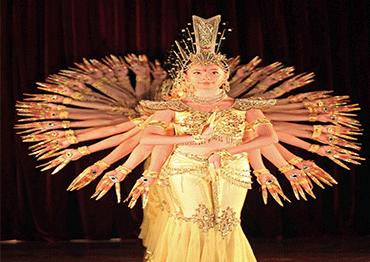
 Old Version
Old Version
